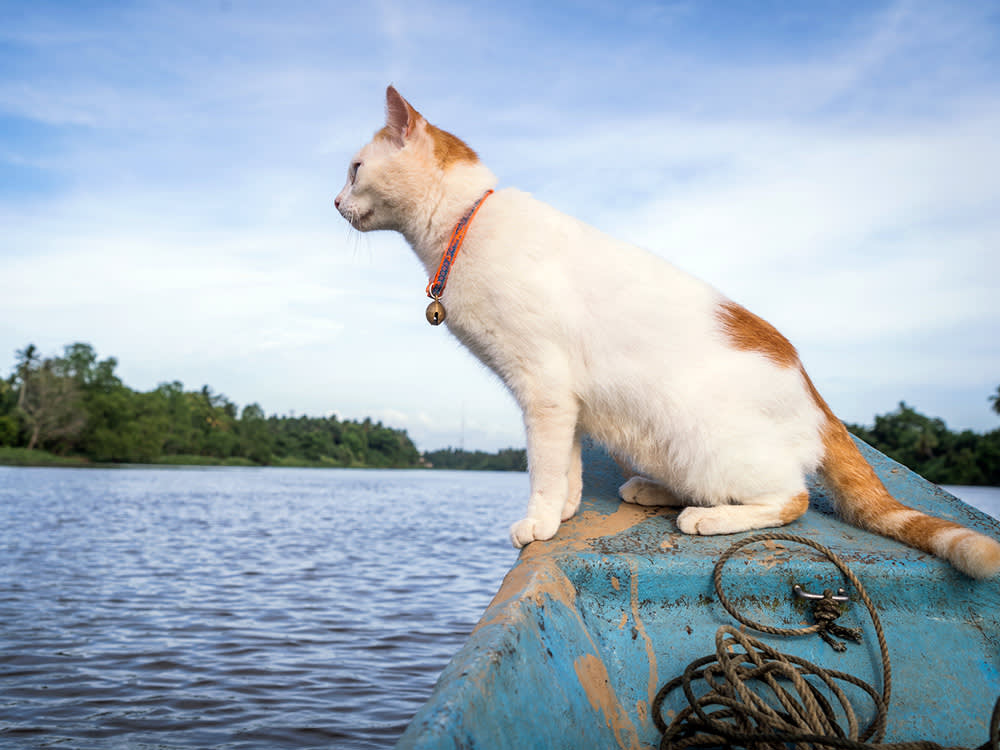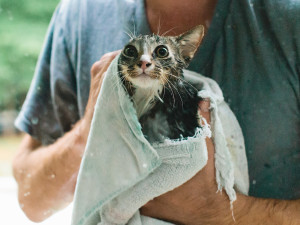Can Cats Swim? What You Need to Know
More importantly: do they want to?
Most dogs love swimming, but would cats literally jump in if given the chance? Cats are relatively new to domesticationopens in new tab and haven’t been selectively bred for tasks like fetching waterfowl. Plus, they evolved from desert-dwelling ancestorsopens in new tab.
It’s only natural that most domestic cats avoid water, yet there are some cats and certain breeds who are curious about it. With proper introduction, training and safety precautions, some cats might be up for playing safely in shallow water under supervision. Some water-loving cats may even practice their swimming skills.
Do cats know how to swim?
Cats naturally know how to swim “in a pinch”, says veterinarian Dr Preston Turanoopens in new tab. And while all cats can swim, they’ll rarely want to swim, he says. In other words, even house cats can swim if they unexpectedly find themselves in deep water – like your bathtub.
But not all cats are skilled swimmers. Some might panic in the water, leading them to ingest it. Other cats, such as Munchkins, might find that their little limbs aren’t efficient paddles.
Reasons most cats avoid water
LeeAnna Buisopens in new tab, a certified feline behaviour consultant, says a cat’s aversion to water can trickle down to three key reasons.
A soggy cat is a vulnerable cat: “A wet coat is a heavy coat,” says Buis. “If a cat’s fur is saturated, it weighs them down.” This is a big deal to cats because they’re both predators and prey. Agility and speed are top priorities, and soggy coats won’t do them any favours.
Cats are neat freaks: “Second, cats like to stay clean,” says Buis. Water doesn’t feel like anything they want to wear, so they lick their fur as soon as possible to remove it.
A drying dilemma: most cats’ fur takes longer to dry compared to many dog breeds. While dogs often have water-repellent fur that allows them to shake off moisture and dry quickly, cats’ coats absorb all that water.
Cat breeds that enjoy swimming
Don’t believe the myth that all cats hate water. There are some breeds who are known to like water more than others, like the below:
Bengals: their wildcat ancestry (Asian leopard cats) might contribute to their attraction to water.
Savannahs: they also have wild cat genes (African Serval).
Turkish Vans: this natural cat breedopens in new tab originated along the shores of Lake Van in Turkey. They’re nicknamed ‘swimming cats’ for their affinity for water.
Maine Coons: Maine Coon cats adapted for the harsh Maine climate. Their thick, water-repellent fur might contribute to their greater appreciation for water compared to other breeds.
Signs your cat might enjoy swimming
If your cat tries to get in the tub or shower with you, they might enjoy swimming. Likewise, cats who like to play in their water bowl or fountain or enjoy batting at toys in the sink or tub could enjoy swimming or other outdoor water activities.
“Many cats enjoy boating and some even live on houseboats,” Turano points out, adding that not all cats need to swim to safely enjoy water or the outdoors.
How to teach your cat to swim
Don’t worry about teaching your cat the basics of swimming; that will come to them naturally. Instead, teaching your cat to comfortably explore water is all about desensitisation and positive reinforcement. If cats are up for it, they can learn new things at any age, says Bius.
Here’s a safe way to desensitise your cat to water and encourage a positive experience.
Start in the bathtub. It’s the easiest place to introduce your cat to water. Hop in with them and bring a few toys. If your cat is experienced in outdoor adventures, the beach of a calm river or lake could also be a good spot. Reward your cat with treats, praise, play or strokes for being comfortable in the environment.
Slowly introduce water. Turn the faucet to a slow trickle so that a small pool of water accumulates around the drain. Allowing your cat to avoid it if they’d like, observing instead. Reward them.
Encourage exploration. Use toys to entice them to touch the water with their paws. Use secure body language, like gently splashing around with your own hands to show that it’s safe. Reward any interaction.
Check in with your cat. If your cat shows any signs of stress, slow down, back up and prioritise their comfort.
Not all cats enjoy the same activities. Batting at mechanical fish toys that swim in the sink rather than heading to a real lake may be more enjoyable to your cat.
Safety precautions for swimming cats
To reduce injury to your cat or even emotional trauma from being in the water, follow these precautions.
Respect their boundaries: never force your cat into water activities. “A common misconception with pet parents is that cats will want to participate in all activities that their pet parents enjoy,” says Turano. The training tips above can help gauge your cat’s interest and safely introduce them to water, but ultimately, follow their lead.
Introduce life jackets: use cat-specific life jackets (cute). Follow the above training tips to familiarise your cat with the life vest and ensure a proper fit before heading out.
Shallow water only: ensure your cat can easily exit the water and keep their head above water at all times.
Constant supervision is key: stay close enough to help your cat if needed. Panicking cats risk drowning or emotional trauma even in shallow water.
Risks of swimming for cats
Water activities with your cat don’t come without risks. First, as mentioned above, you’ll need to be especially careful to keep a close eye on your cat while they are swimming. You never want your cat to feel stressed or panic while they are in the water. There are risks of drowning (again, a shout-out to life jackets), and you should never force your cat to swim if they clearly are resistant to doing so.
Can cats swim in chlorine pools?
No, you should not let your cat swim in a pool that contains chlorine. According to Dr Renee Schmidopens in new tab, senior veterinary toxicologist and director of veterinary medicine at the Pet Poison Helplineopens in new tab, ingesting pool water can cause vomiting and drooling in cats. The danger doesn’t end when your cat exits the pool; cats instinctively groom after getting wet.
Dr Schmid adds that if your cat comes into contact with concentrated chlorine tablets used for pool maintenance, it can lead to serious corrosive injuries in the mouth, esophagus and stomach.
Signs of chlorine poisoning include:
pawing at the mouth
ulcers in the mouth
mouth pain
Health benefits of swimming
Swimming can benefit cats of all ages. It’s a low-impact exercise that tones all sorts of muscles. Because water alleviates stress on the joints, veterinarians and physical therapists might even prescribe the use of an underwater treadmill for overweight cats or those needing physical rehabilitation.
Swimming might not be for every cat, but even water-based activities, like kayaking or canoeing, can offer an enriching experience. But once again, don’t forget that life jacket.
Frequently asked questions
Can domestic cats swim?
According to Dr Turano, all domestic cats instinctively know how to swim, but their swimming skills and enjoyment of water can vary.
Can cats swim in the sea?
You should not swim in the sea with your cat – the sea adds an extra layer of dangers for swimming cats, like strong currents, rip tides, shallow areas that can quickly become deep and unfamiliar wildlife. Ingesting too much salt water can also lead to salt poisoning.












